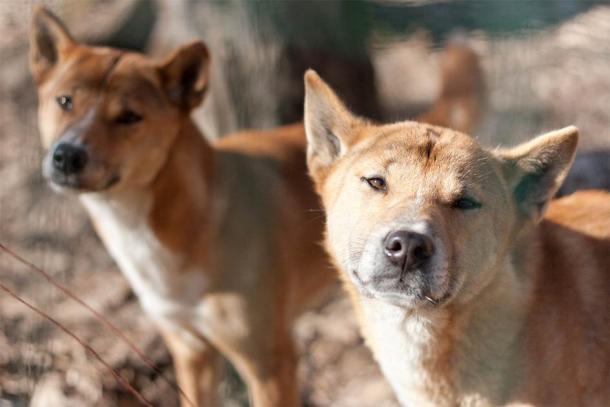A new study of a rare, unique breed of domesticated dog, originally from Papua New Guinea and believed to be extinct decades ago, has found that they still exist in the wild. The domesticated singing dogs are the same breed as the reclusive hounds that wander remote areas in New Guinea. They are known as singing dogs because of their unique vocalizations. And by understanding the evolution of these rare singing dogs, we may get a better understanding of how humans first began to speak and sing.
The important findings were made by the Indonesian National Human Genome Research Institute (NHGRI) in collaboration with other academic organizations. The researchers wrote in PNAS that the “New Guinea singing dogs are identifiable by their namesake vocalizations, which are unlike any other canid population.” Because of the way that they were domesticated, these dogs can make harmonic and tonal sounds, that are quite musical. They were only discovered in 1897 and “their taxonomy remains controversial in part due to the availability of only captive specimens for genetic analysis and debate regarding their origins,” the researchers wrote in PNAS.

Two Highland Wild Dogs photographed in Papua New Guinea (Aubord Dulac / Adobe Stock )
Singing Dogs Are An Endangered Captive Population
Only 200 or 300 singing dogs exist in captivity and none have been seen in the wild for almost 50 years. NIH quotes Dr Elaine Ostrander, who took part in the study, as saying that, “The New Guinea singing dog that we know of today is a breed that was basically created by people.” A number were brought to the United of States from the New Guinea Highlands , and they were bred to save the species. Dr Ostander told NIH that “captive New Guinea singing dogs have most likely lost a large number of genomic variants that existed in their wild counterparts.” This lack of genetic variation could threaten their long-term survival.
The research study was undertaken to better understand singing dogs, so that they could be conserved. In 2016, the New Guinea Highland Wild Dog Foundation (NGHWDF), in collaboration with the University of Papua, uncovered biological evidence of the existence of 15 Highland Wild Dogs, near the Gasberg Mine, one of the world’s biggest gold mines. There have been almost no sightings of these wild dogs in recent decades as they are reclusive and live in remote environments. Blood samples and measurements from two Highland Wild Dogs were obtained in 2018 after they were trapped using coyote calls and skunk essence. The NHGRI reports that “Researchers previously hypothesized that the Highland Wild Dog might be the predecessor to captive New Guinea singing dogs.”
Analysis Of The Highland Wild Dog Genome
The team were able to sequence the genomes of the Highland Wild Dogs from the biological samples and compared the results to the domesticated singing dog genomes. What they found was a complete surprise.
Dr Heidi Parker oversaw the genomic analyses, comparing the DNA from captive New Guinea singing dogs and Highland Wild Dogs. She is quoted by NHGRI as saying that, “We found that New Guinea singing dogs and the Highland Wild Dogs have very similar genome sequences, much closer to each other than to any other canid known.” It was established that they are very closely related.

An aging domesticated New Guinea singing dog. (SailingAway / Adobe Stock )
Therefore, the two dog types are from the same species, Canis lupus familiaris , which was a surprise. The canines may have different names but are essentially the same. Therefore, the New Guinea singing dog is not extinct in the wild, and its ancestral population still roams the remote highlands.
These Domesticated And Wild Dogs Are The Same Species
It may be possible to breed Highland Wild Dogs with the domesticated breed. The NIH reports that “breeding some of the Highland Wild Dogs with the New Guinea singing dogs in conservation centers will help generate a true New Guinea singing dogs population.” This will ensure the long-term survival of these rare and remarkable canines by giving them the required genetic diversity to maintain a healthy population.
The dogs come from a very ancient breed. Dr Ostrander told NHGRI that “By getting to know these ancient, proto-dogs more, we will learn new facts about modern dog breeds and the history of dog domestication.” It can also help us to understand the ancient people of Oceania who domesticated these canines.
Further Study Could Help With Human Speech Problems
The researchers want to conduct more studies on the New Guinea singing dogs to understand the genes involved in vocalization. Human biology is remarkably similar to dogs. The NIH reports that this means that experts can “gain a more accurate insight into how vocalization” developed in people. This is very important as this knowledge can also help researchers to understand conditions related to deficits in vocalization. One day this could lead to new and improved treatments to help people with speech disorders .
Top image: A domesticated New Guinea singing dog, singing. Source: R.G. Daniel / CC BY 2.0
By Ed Whelan
Related posts:
Views: 0
 RSS Feed
RSS Feed

















 September 2nd, 2020
September 2nd, 2020  Awake Goy
Awake Goy  Posted in
Posted in  Tags:
Tags: 
















